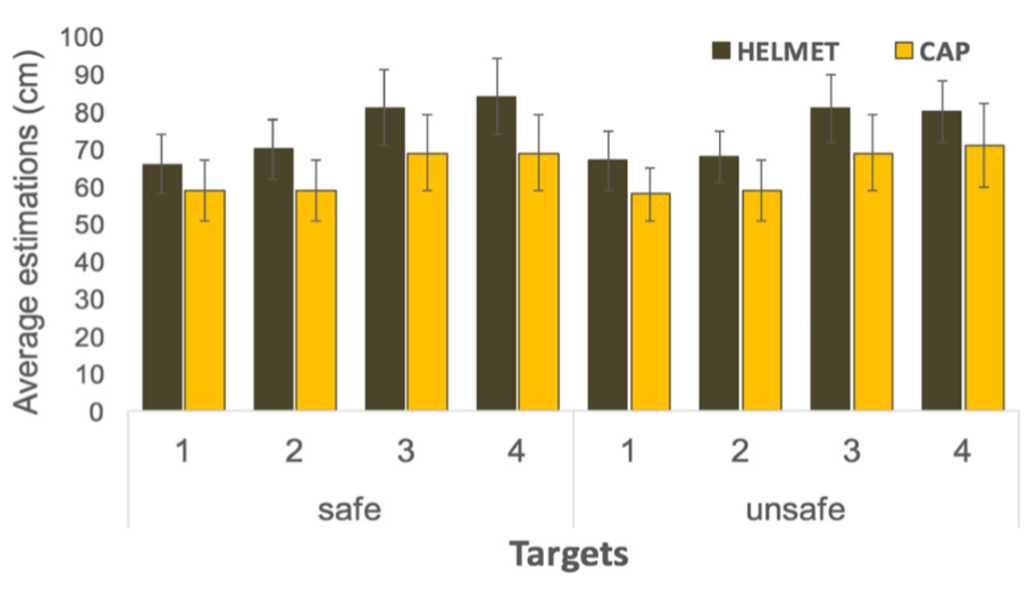Humans have a sort Dr. Jekyll/Mr. Hyde relationship with safety devices, such as helmets. For example, on the one hand bicycle helmets are known to reduce serious head injuries (by 70%, it turns out). On the other hand, helmets might also lead to more risky behavior. For instance, cyclists are often thought to ride faster and/or more aggressively when wearing safety helmets (although there is much debate surrounding this claim). In this way, the perceived sense of additional safety and security provided by the helmet leads individuals to be more risk seeking.
The tendency to take increased risks when wearing protective equipment is known as a compensatory behavior. Interestingly, people engage in compensatory behaviors even when the worn protective equipment (e.g., a helmet) is irrelevant for the task at hand (e.g., inflating balloons close to popping limit).
Studies regarding safety equipment and compensatory behaviors are vast. They include investigations of seatbelts, child-restraint medicine bottle caps, condom use, cigarette lighters, and so on.
Understanding the relationship between safety equipment and compensatory behaviors has important implications for law and public policy. Cognitive Psychology provides a valuable toolkit for investigations that can shed light on this relationship, given its significance to society.
To this end, a recent article in the Psychonomic Society’s journal, Attention, Perception, and Psychophysics, sought to  explore the interaction between safety equipment and using compensatory strategies to make perceptual judgments of targets. More specifically, researchers Magda Dumitru and Achille Pasqualotto investigated how wearing a helmet (versus wearing a baseball cap) affects egocentric distance (for both depth and visual angle) estimates of threatening and non-threatening targets.
explore the interaction between safety equipment and using compensatory strategies to make perceptual judgments of targets. More specifically, researchers Magda Dumitru and Achille Pasqualotto investigated how wearing a helmet (versus wearing a baseball cap) affects egocentric distance (for both depth and visual angle) estimates of threatening and non-threatening targets.
In the experiment, two decks of 16 cards were used. One deck contained pictures of non-threatening animals (e.g., dog and rabbit) and the other contained pictures on threatening animals (e.g., tiger and shark). On each trial of the experiment, participants were shown one card at a time and were asked to estimate the distance of the card with respect to where they were seated and name the animal presented on the card.
On a given trial, a randomly chosen card would appear at one of eight locations relative to the participant. Four of the eight locations were in the participant’s right field of vision and the other four in the left field. In each field (right or left), two card locations were close to the participant, one at a narrow visual angle and the other at a wide visual angle. The remaining two card locations in that visual field were further away from the participant, one at narrow angle and the other at a wide angle. Importantly, for cards presented further away, participants were instructed to turn 180 degrees so that their backs touched the table and view the cards through a hand held mirror. The figure below illustrates the setup.

Based on this task design, Dumitru and Pasqualotto tested several hypotheses:
- In general, perceptual judgments of distance will vary with target type for participants wearing a helmet. When estimating the distance of threatening targets, individuals will not risk-compensate, but instead focus on the costs associated with the estimate (i.e., the cost of encountering a threat). In this way, threatening targets will be perceived as closer than non-threatening targets.
- Wearing a helmet will induce a positive affect (i.e., a sense of security), which in turn will result in attentional widening and higher sensitivity to neutral (non-threatening) targets (presented at both narrow and wide angles).
- Alternatively, if the affect arising from wearing a helmet is modulated by target type, then threatening targets will result in attentional narrowing (less sensitivity to target angles), compared to non-threatening targets.
Interestingly, Dumitru and Pasqualotto found a difference in performance across all three factors: headgear type, distance, and threat level of the target. First, helmet wearers reported estimates that were closer to the Euclidean distance of targets to the observation point, compared with baseball cap wearers who tended to underestimate distances. In addition, helmet wearers estimated distances of non-threatening targets as being greater than distances of threatening targets. In other words, threatening targets were perceived as being closer than non-threatening targets. Also, for non-threatening targets, helmet wearers were sensitive to both depth and angle locations, such that they could distinguish between distances at all presented locations (positions 1 vs. 2 vs. 3 vs. 4). The figure below summarizes the results.

For threatening targets, helmet wearers could only distinguish between depth levels (positions 1&2 vs. 3&4), but not visual angles within depth levels (positions 1 vs. 2 and 3 vs. 4). This means that helmet wearers focused more heavily on the costs associated with the targets, and were not risk-compensating.
In contrast, cap wearers only distinguished between depth but not visual angle. Also, there were no differences in estimations of the distance of non-threatening and threatening targets for cap wearers.
Although the debate between safety equipment and compensatory behaviors wages on, this study finds support that individuals only risk-compensate when the cost is low (i.e. non-threatening situations), and are more conservative in their estimates when there is a potential threat present.
Featured Psychonomic Society article:
Dumitru, M. L., & Pasqualotto A. (2018). Helmets improve estimations of depth and visual angle to safe targets. Attention, Perception, & Psychophysics DOI: 10.3758/s13414-018-1605-9.
